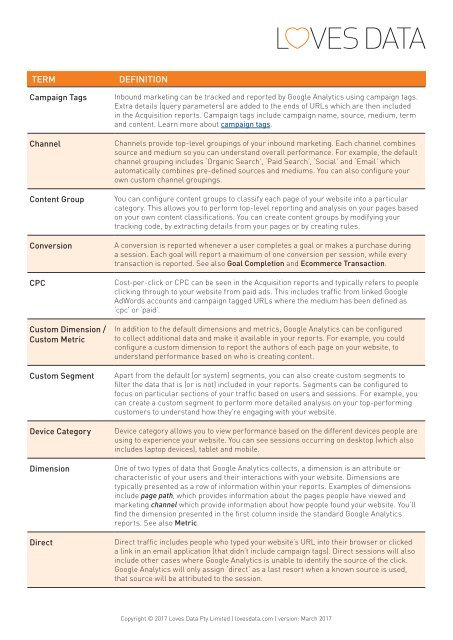GA_Glossary_March_2017
Create successful ePaper yourself
Turn your PDF publications into a flip-book with our unique Google optimized e-Paper software.
TERM<br />
Campaign Tags<br />
Channel<br />
Content Group<br />
Conversion<br />
CPC<br />
Custom Dimension /<br />
Custom Metric<br />
Custom Segment<br />
Device Category<br />
Dimension<br />
Direct<br />
DEFINITION<br />
Inbound marketing can be tracked and reported by Google Analytics using campaign tags.<br />
Extra details (query parameters) are added to the ends of URLs which are then included<br />
in the Acquisition reports. Campaign tags include campaign name, source, medium, term<br />
and content. Learn more about campaign tags.<br />
Channels provide top-level groupings of your inbound marketing. Each channel combines<br />
source and medium so you can understand overall performance. For example, the default<br />
channel grouping includes ‘Organic Search’, ‘Paid Search’, ‘Social’ and ‘Email’ which<br />
automatically combines pre-defined sources and mediums. You can also configure your<br />
own custom channel groupings.<br />
You can configure content groups to classify each page of your website into a particular<br />
category. This allows you to perform top-level reporting and analysis on your pages based<br />
on your own content classifications. You can create content groups by modifying your<br />
tracking code, by extracting details from your pages or by creating rules.<br />
A conversion is reported whenever a user completes a goal or makes a purchase during<br />
a session. Each goal will report a maximum of one conversion per session, while every<br />
transaction is reported. See also Goal Completion and Ecommerce Transaction.<br />
Cost-per-click or CPC can be seen in the Acquisition reports and typically refers to people<br />
clicking through to your website from paid ads. This includes traffic from linked Google<br />
AdWords accounts and campaign tagged URLs where the medium has been defined as<br />
‘cpc’ or ‘paid’.<br />
In addition to the default dimensions and metrics, Google Analytics can be configured<br />
to collect additional data and make it available in your reports. For example, you could<br />
configure a custom dimension to report the authors of each page on your website, to<br />
understand performance based on who is creating content.<br />
Apart from the default (or system) segments, you can also create custom segments to<br />
filter the data that is (or is not) included in your reports. Segments can be configured to<br />
focus on particular sections of your traffic based on users and sessions. For example, you<br />
can create a custom segment to perform more detailed analysis on your top-performing<br />
customers to understand how they’re engaging with your website.<br />
Device category allows you to view performance based on the different devices people are<br />
using to experience your website. You can see sessions occurring on desktop (which also<br />
includes laptop devices), tablet and mobile.<br />
One of two types of data that Google Analytics collects, a dimension is an attribute or<br />
characteristic of your users and their interactions with your website. Dimensions are<br />
typically presented as a row of information within your reports. Examples of dimensions<br />
include page path, which provides information about the pages people have viewed and<br />
marketing channel which provide information about how people found your website. You’ll<br />
find the dimension presented in the first column inside the standard Google Analytics<br />
reports. See also Metric.<br />
Direct traffic includes people who typed your website’s URL into their browser or clicked<br />
a link in an email application (that didn’t include campaign tags). Direct sessions will also<br />
include other cases where Google Analytics is unable to identify the source of the click.<br />
Google Analytics will only assign ‘direct’ as a last resort when a known source is used,<br />
that source will be attributed to the session.<br />
Copyright © <strong>2017</strong> Loves Data Pty Limited | lovesdata.com | version: <strong>March</strong> <strong>2017</strong>


